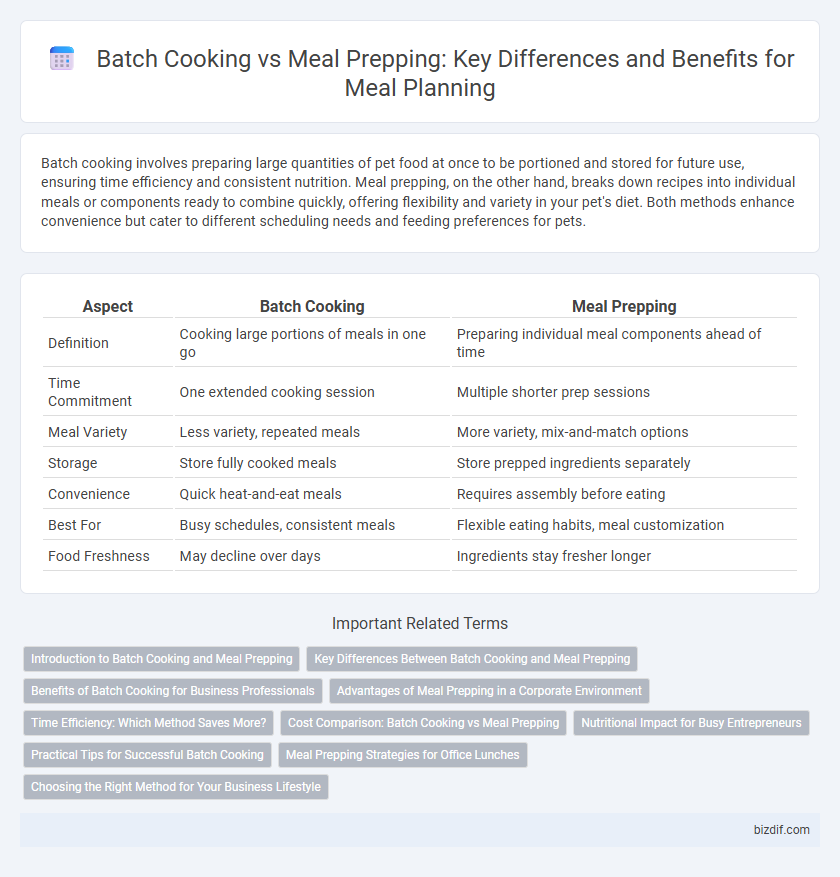Batch cooking involves preparing large quantities of pet food at once to be portioned and stored for future use, ensuring time efficiency and consistent nutrition. Meal prepping, on the other hand, breaks down recipes into individual meals or components ready to combine quickly, offering flexibility and variety in your pet's diet. Both methods enhance convenience but cater to different scheduling needs and feeding preferences for pets.
Table of Comparison
| Aspect | Batch Cooking | Meal Prepping |
|---|---|---|
| Definition | Cooking large portions of meals in one go | Preparing individual meal components ahead of time |
| Time Commitment | One extended cooking session | Multiple shorter prep sessions |
| Meal Variety | Less variety, repeated meals | More variety, mix-and-match options |
| Storage | Store fully cooked meals | Store prepped ingredients separately |
| Convenience | Quick heat-and-eat meals | Requires assembly before eating |
| Best For | Busy schedules, consistent meals | Flexible eating habits, meal customization |
| Food Freshness | May decline over days | Ingredients stay fresher longer |
Introduction to Batch Cooking and Meal Prepping
Batch cooking involves preparing large quantities of meals at once, which are then portioned and stored for future consumption, optimizing time and reducing daily cooking stress. Meal prepping refers to the process of planning and preparing individual meal components or entire meals ahead of time, ensuring convenience and balanced nutrition throughout the week. Both techniques enhance efficiency in the kitchen, but batch cooking emphasizes quantity, while meal prepping focuses on meal organization and portion control.
Key Differences Between Batch Cooking and Meal Prepping
Batch cooking involves preparing large quantities of a single dish or a few dishes at once to be consumed over several days, optimizing time and reducing cooking frequency. Meal prepping encompasses planning and portioning entire meals ahead of time, often including various components and snacks, ensuring balanced nutrition and convenience throughout the week. The key difference lies in batch cooking focusing on bulk production of fewer dishes, while meal prepping centers on diverse, ready-to-eat meals tailored for daily consumption.
Benefits of Batch Cooking for Business Professionals
Batch cooking maximizes time efficiency for business professionals by preparing large portions of meals that can be divided into multiple servings, reducing daily cooking demands. This method enhances nutritional control and cost savings by minimizing reliance on takeout or processed foods during busy workweeks. Consistent meal availability supports better energy management and productivity, essential for maintaining focus and performance in high-pressure professional environments.
Advantages of Meal Prepping in a Corporate Environment
Meal prepping in a corporate environment streamlines daily lunch routines by providing ready-to-eat, portion-controlled meals that save time and reduce dependence on unhealthy fast food options. It enhances productivity by minimizing lunchtime decision fatigue and supports healthier eating habits tailored to individual dietary needs. Meal prepping also offers cost savings through bulk purchasing and minimizes food waste compared to spontaneous meal choices.
Time Efficiency: Which Method Saves More?
Batch cooking saves more time by preparing large quantities of meals in one session, reducing daily cooking efforts and cleanup. Meal prepping involves portioning and assembling meals ahead of time, which can add time each day for customization but offers flexibility. Overall, batch cooking is more time-efficient for those seeking minimal daily kitchen activity.
Cost Comparison: Batch Cooking vs Meal Prepping
Batch cooking often reduces overall food costs by allowing bulk ingredient purchases and minimizing waste through repeated use of components across multiple meals. Meal prepping can lead to savings by portion control and avoiding last-minute takeout expenses but may involve higher upfront costs due to varied ingredient needs. Evaluating local grocery prices and personal consumption patterns helps determine which method offers better financial efficiency.
Nutritional Impact for Busy Entrepreneurs
Batch cooking and meal prepping both enhance nutritional intake for busy entrepreneurs by ensuring consistent access to balanced meals, reducing reliance on fast food or unhealthy snacks. Batch cooking allows for preparing large quantities of diverse meals that retain nutrient density when properly stored, while meal prepping focuses on portion control and tailored macronutrient distribution to meet specific dietary goals. Prioritizing nutrient-rich ingredients and minimizing processed foods within these methods supports sustained energy levels and improved cognitive performance crucial for entrepreneurial productivity.
Practical Tips for Successful Batch Cooking
Batch cooking involves preparing large quantities of meals at once, which can save time and reduce daily cooking stress during busy weeks. Practical tips for successful batch cooking include selecting versatile recipes that store well, using airtight containers to maintain freshness, and organizing meals by portion size to simplify reheating. Incorporating a variety of proteins, vegetables, and grains ensures balanced nutrition while preventing monotony in your weekly menu.
Meal Prepping Strategies for Office Lunches
Meal prepping for office lunches involves preparing individual meals or components in advance to ensure convenience and balanced nutrition throughout the workweek. Strategies include portioning meals in airtight containers, incorporating diverse ingredients like lean proteins, whole grains, and fresh vegetables, and using recipes that reheat well to maintain flavor and texture. Optimizing meal prep with versatile ingredients and efficient storage solutions reduces stress and supports healthy eating habits during busy office hours.
Choosing the Right Method for Your Business Lifestyle
Batch cooking involves preparing large quantities of meals at once and freezing portions for future use, ideal for businesses seeking efficiency and consistent menu offerings. Meal prepping focuses on organizing ingredients or meals in advance for quicker daily assembly, benefiting ventures with dynamic menus and customization needs. Assessing factors such as kitchen capacity, workflow, and customer demand helps determine the best approach to optimize operations and minimize food waste.
Batch Cooking vs Meal Prepping Infographic

 bizdif.com
bizdif.com